

THE MYSTERY OF OSIRIS
Osiris, Usire Asar, Ausar, Unnefer, Wesir
The Egyptians worshipped |
You will find duplications |
WEBSITE OF ZAWI HAWASS AND THE DISCOVERIES
In addition to native variations by locality or over time, there are often several possible transliterations into the Roman alphabet used for English.)
 English name:
Green Man (the term “Green Man” refers to a class of deities from many different
traditions, of which Asar is a Tameran example — Asar was commonly depicted
as a green man)
English name:
Green Man (the term “Green Man” refers to a class of deities from many different
traditions, of which Asar is a Tameran example — Asar was commonly depicted
as a green man)
THE MYSTERY OF OSIRIS
Osiris plays a key role and is a central figure in the ancient Egyptian mysteries and in the Order Of The Morning Star. It was Osiris who was the beloved pharaoh of Egypt. It was Osiris who taught the people of the land of Egypt about farming. Osiris was and is one of the first "Green Men", in that he was also the god of vegetation. When Osiris became ruler over the land of Egypt, the people were engaged in the practice of cannibalism. Osiris helped them to evolve beyond cannibalism and to learn farming skills.
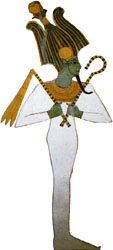 Osiris is the husband of Isis. In that after thousands of years all female goddesses
became merged as an aspect of Isis, she too is central to Egyptian symbolism.
Most scholars know of the tragic story of the death of Osiris. He was murdered
by his evil brother Set. Set is equated with Typhon-Apophis of the Greeks. Set is the destructive aspect that the alchemical
principal must undergo, and thus be reborn into a new and purified creation.
(Satan is based on the personage of Set) That is exactly what happened to
Osiris. His death or as the alchemist would say his putrefaction was carefully
evolved through the power of Isis under the magical direction of Thoth.
Osiris is the husband of Isis. In that after thousands of years all female goddesses
became merged as an aspect of Isis, she too is central to Egyptian symbolism.
Most scholars know of the tragic story of the death of Osiris. He was murdered
by his evil brother Set. Set is equated with Typhon-Apophis of the Greeks. Set is the destructive aspect that the alchemical
principal must undergo, and thus be reborn into a new and purified creation.
(Satan is based on the personage of Set) That is exactly what happened to
Osiris. His death or as the alchemist would say his putrefaction was carefully
evolved through the power of Isis under the magical direction of Thoth.
Essentially, a formula was being created in the mythos. It is the alchemical formula of I.A.O., Isis, Apophis, Osiris, Birth, Death, resurrection. To the Adept this is a powerful process of transformation that unlocks the keys of magical power and of immortality.
For as Osiris died, through the power of Birth (Isis) under the authority and skill of Thoth (The Higher Genius) Osiris arose on the physical plane as the great avenging god Horus, his son. On the spiritual plane Osiris became the great god of the underworld. Like Christ he became the god that the Egyptians needed to become in order to be saved. What this means is that unless the initiate allows for the complete transformation of the self under the direct guidance of the Higher, no true and lasting power can be obtained. Osiris is the reconciler with the Lower Selfhood in which no birth or death is necessary. We can refer to it as "The Bornless One."
To the Egyptians one must become Osiris. In that no one can or could deliver the forty-two negative confessions in the hall of truth, because no one is perfect in earthly life. By identification with Osiris the candidate who stands in the Hall of Truth can indeed deliver the negative confession. The reason is clear, it is not him, but him in Osiris that is delivering the negative confession. The candidate in the Hall of Truth is redeemed by his unification with Osiris.This unification in the Morning Star system takes place in the grade of 5=6, Adeptus Minor. Of the details I can speak no more.
In the Hall of the Neophyte it is the Hierophant who sits in the Osirisian position on the path of Samekh outside of Tiphareth. Osiris is the one in the Hall of the Neophyte who confirms the initiation on the new candidate. This is done after the candidate has taken the oath and is placed in the northwest part of the hall.
"I am the only being in an abyss of Darkness. From an abyss of Darkness came I forth ere my birth, from the silence of a primal sleep. And the voice of ages said unto my soul, 'I am he who formulates in Darkness, the Light that shineth in the Darkness, yet the Darkness comprehendeth it not.' Let the mystical circumambulation take place onto the Path of Darkness that leadeth unto Light with the Lamp of Hidden Knowledge to guide the way."
Asar [Osiris]: God of life and death. Husband and brother of Aset, brother of Set, Nebt Het, and Heru the Elder, son of Nut and Geb, and father of the twins, Bast and Heru, lover of Nebt Het, and father of Anpu. Asar is shown as a virile green man or as a mummified black man. See also information on the religious item known as the Djed.
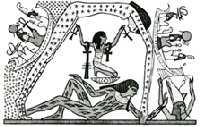 |
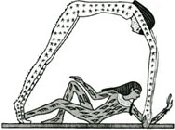 |
| The goddess was typically portrayed as a woman who wears on her head
a vase of water . Many times she is shown as a woman whose hands and feet
touch the ground so that her body forms a semi-circle. As such she represents
the heavens. Her arms and legs represent the four pillars on which the sky
rests. She is held up by her father Shu (the god of the air). Her husband
Geb lies on the ground reclining on one elbow and his knees in the air. In
this position he depicts the hills and valleys of the land. It was said that
when Shu raised Nut (the sky) above Geb (the earth) he brought an end to
chaos and if he ever left this position, chaos would return.
In one myth Nut gives birth to the Sun-god daily and he passes over her body until he reaches her mouth at sunset. He then passed into her mouth and through her body and is reborn the next morning. Another myth described the sun as sailing up her legs and back in the Atet (Matet) boat until noon, when he entered the Sektet boat and continued his travels until sunset. |
 |
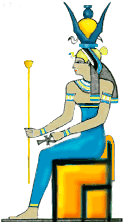 |
NUT |
 Egyptian god of the underworld and of
vegetation. Son of
Nut and
Geb. His
birthplace was said to be Rosetau in the necropolis west of Memphis. Brother
of Nephthys and Seth, and the brother and husband of Isis.
Egyptian god of the underworld and of
vegetation. Son of
Nut and
Geb. His
birthplace was said to be Rosetau in the necropolis west of Memphis. Brother
of Nephthys and Seth, and the brother and husband of Isis.
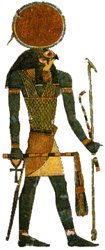 |
 |
HORUS |
HORUS |
 Isis
Hathor gave birth to Horus after
his death, having impregnated herself with semen from his corpse.
[Horus birth & Flight]
Isis
Hathor gave birth to Horus after
his death, having impregnated herself with semen from his corpse.
[Horus birth & Flight]
Osiris was depicted in human form wrapped up as a mummy, holding the crook and flail. He was often depicted with green skin, alluding to his role as a god of vegetation. He wore a crown known as the 'atef', composed of the tall conical white crown of Upper Egypt with red plumes on each side. Osiris had many cult centers, but the most important were at Abydos (Ibdju) in Upper Egypt, where the god's legend was reenacted in an annual festival, and at Busiris (Djedu) in the Nile delta.
One of the so-called "dying gods", he was the focus of a famous legend in which he was killed by the rival god Seth. At a banquet of the gods, Seth fooled Osiris into stepping into a coffin, which he promptly slammed shut and cast into the Nile. The coffin was born by the Nile to the delta town of Byblos, where it became enclosed in a tamarisk tree. Isis, the wife of Osiris, discovered the coffin and brought it back. (The story to this point is attested only by the Greek writer Plutarch, although Seth was identified as his murderer as early as the Pyramid era of the Old Kingdom.)
Seth took advantage of Isis's temporary absence on one occasion, cut the body to pieces, and cast them into the Nile. (In the Egyptian texts this incident alone accounts for the murder of Osiris.) After Seth killed Osiris, Horus, his son, became Pharoah. Seth was jealous of him as well, so he fought Horus for the throne. Seth took out Horus' eye in the battle. Thoth, the god of wisdom, found the eye and put it together. It is now called the Eye of Horus, or the wedjet eye. The eye is one of the main symbols of Egyptian mythology. Horus became one of the main Egyptian gods.
Isis searched the land for the body parts of Osiris, and was eventually able to piece together his body, whole save for the penis, which had been swallowed by a crocodile (according to Plutarch) or a fish (according to Egyptian texts). In some Egyptian texts, the penis is buried at Memphis. Isis replaced the penis with a reasonable facsimile, and she was often portrayed in the form of a kite being impregnated by the ithyphallic corpse of Osiris. In some Egyptian texts, the scattering of the body parts is likened to the scattering of grain in the fields, a reference to Osiris's role as a vegetation god. 'Osiris gardens' - wood-framed barley seedbeds in the shape of the god, were sometimes placed in tombs - and the plants which sprouted from these beds symbolized the resurrection of life after death.
It was this legend that accounted for Osiris's role as a god of the dead and ruler of the Egyptian underworld. He was associated with funerary rituals, at first only with those of the Egyptian monarch, later with those of the populace in general. The pharaoh was believed to become Osiris after his death. Although he was regarded as a guarantor of continued existence in the afterlife, Osiris also had a darker, demonic aspect associated with the physiological processes of death and decay, and reflecting the fear Egyptians had of death in spite of their belief in an afterlife. Osiris was also a judge of the dead, referred to as the 'lord of Maat' (i.e. of divine law).
Legendary ruler of predynastic Egypt and god of the underworld. Osiris symbolized the creative forces of nature and the imperishability of life. Called the great benefactor of humanity, he brought to the people knowledge of agriculture and civilization. The worship of Osiris, one of the great cults of ancient Egypt, gradually spread throughout the Mediterranean world and, with that of Isis and Horus, was especially vital during the Roman Empire.
Osiris (Ausar)
The god of the dead, and the god of the resurrection into eternal life; ruler, protector, and judge of the deceased, and his prototype (the deceased was in historical times usually referred to as "the Osiris"). His cult originated in Abydos, where his actual tomb was said to be located.
Osiris was the first child of Nut and Geb, thus the brother of Set, Nephthys, and Isis, who was also his wife. By Isis he fathered Horus, and according to some stories, Nephthys assumed the form of Isis, seduced him thus, and from their union was born Anubis.
Osiris ruled the world of men in the beginning, after Ra had abandoned the world to rule the skies, but he was murdered by his brother Set. Through the magic of Isis, he was made to live again. Being the first living thing to die, he subsequently became lord of the dead. His death was avenged by his son Horus, who defeated Set and cast him out into the desert to the West of Egypt (the Sahara).
Prayers and spells were addressed to Osiris throughout Egyptian history, in hopes of securing his blessing and entering the afterlife which he ruled; but his popularity steadily increased through the Middle Kingdom. By Dynasty XVIII he was probably the most widely worshipped god in Egypt. His popularity endured until the latest phases of Egyptian history; reliefs still exist of Roman emperors, conquerors of Egypt, dressed in the traditional garb of the Pharaohs, making offerings to him in the temples.
Osiris, King Of The Underworld
From Lenoir’s La Franche-Maconnerie.
Osiris is often represented with the lower part of his body enclosed in a mummy case or wrapped about with funeral bandages. Man’s spirit consists of three distinct parts, only one of which incarnates in physical form. The human body was considered to be a tomb or sepulchre of this incarnating spirit. Therefore Osiris, a symbol of the incarnating ego, was represented with the lower half of his body mummified to indicate that he was the living spirit of man enclosed within the material form symbolized by the mummy case.
 |
RE |
There is a romance between the active principle of God and the passive principle of Nature. From the union of these two principles is produced the rational creation. Man is a composite creature. From his Father (the active principle) he inherits his Divine Spirit, the fire of aspiration—that immortal part of himself which rises triumphant from the broken clay of mortality: that part which remains after the natural organisms have disintegrated or have been regenerated. From his Mother (the passive principle) he inherits his body—that part over which the laws of Nature have control: his humanity, his mortal personality, his appetites, his feelings, and his emotions.
The Egyptians also believed that Osiris was the river Nile and that Isis (his sister-wife) was the contiguous land, which, when inundated by the river, bore fruit and harvest. The murky waters of the Nile were believed to account for the blackness of Osiris, who was generally symbolized as being of ebony hue. MPH
**************
Thereafter Osiris was worshipped both as a fertility god, who ensured the rebirth of vegetation each spring and as Lord of the underworld, through whom all live again.
Osiris sat at the entrance to the underworld. Only those who could satisfy him of their goodness during life gained admission. thus all made offerings to Osiris in hope of his favour.
Osiris is usually shown as a crowned king, holding a crook and a flail. He is usually depicted black, the colour of death.
| The picture below is a photograph of what you might call an Egyptian map of the universe, or at least one-half of it: the journey of the sun through the Underworld. The painting shows the journey of Re, the sun-god, travelling through the Underworld in his solar barque, a journey he undertakes every night. The bottom of the painting shows a barque filled with several gods of the Egyptian pantheon (outside of Ra and Osiris, these gods are difficult to identify for they have no distinguishing marks); on either side of these deities are the souls of royal dead in one case praising and in the other case worshipping these gods. This painting graces the walls of the tomb of Sennedjem (Seti I), who ruled in the Nineteenth Dynasty during the New Kingdom (see the Egyptian Timeline). |
|
OSIRIS - THE GOD OF DEATH AND REBIRTH
 Although the
cult of the sun-god was the state cult of Egypt, the most important god in
terms of religious practice was Osiris, the god of the living and the dead.
For the cult of Osiris applied to everyone, from the king down to the lowest
member of society. Osiris was a god of fertility; all the principal Egyptian
gods (including the pharoah who was God Incarnate) were creator gods, that
is, they gave life to the world. Since Osiris gave life to the living and
the dead, the pharoah was generally regarded as the incarnation of
Osiris—in fact, the very name of the god, Us-Yri, means "Occupier of
the Throne."
Although the
cult of the sun-god was the state cult of Egypt, the most important god in
terms of religious practice was Osiris, the god of the living and the dead.
For the cult of Osiris applied to everyone, from the king down to the lowest
member of society. Osiris was a god of fertility; all the principal Egyptian
gods (including the pharoah who was God Incarnate) were creator gods, that
is, they gave life to the world. Since Osiris gave life to the living and
the dead, the pharoah was generally regarded as the incarnation of
Osiris—in fact, the very name of the god, Us-Yri, means "Occupier of
the Throne."
Osiris's principle function as the god of the dead was to judge the soul of the deceased. If that soul were found to be pure and sinless, it would be admitted into the realms of bliss; if it were to be found in any way weighted with sin or crime, it was thrown to Amenti, a horrid god with the face of a crocodile, the front of a leopard, and the back of a rhinoceros, who would consume the soul in its frightening jaws. So Osiris was the god that every soul had to answer to after death, accounting for all aspects of the life lived on earth.
Osiris didn't just fall into this role. According to Osiris legends, as an incarnate god in the body of a pharoah, he was married to his sister, Isis. Their brother, Setekh, was also married to another sister, Nephthys. Through a ruse, Setekh murdered Osiris and threw his body, locked in a coffin, into the Nile. When Isis recovered the body, Setekh tore it into many pieces and threw them back into the Nile. Isis reassembled all the pieces and breathed life back into the body; they then had a child, Horus, who would become the god of the sun. Isis herself turned into a hawk; so most tombs in Egypt have an image of a hawk with its wings spread out as a symbol of rebirth.
So Osiris represents many things for the Egyptians. As someone who died and was then reborn, he represents the cycle of death and rebirth which the Egyptians saw as the dominant principle and promise of the universe. As the god of fertility and the Nile, Osiris brought life, in the form of agriculture, to all living humans. Incarnate in the pharoah or king, Osiris created life for the living in the administration of the state. As the lord of the dead, Osiris represented the moral order of the universe, judging each soul by its life and rewarding or punishing that soul with a rigorous justice.
LIBRA (The Scales)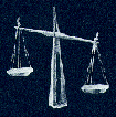
There are other Biblical verses that tie in, in my way of seeing things. In Genesis 8:21, the Lord said in his heart, ". . . for the imagination of man's heart is evil from his youth; . . ." This is why He brought on the flood. Proverbs 21:2 says, "Every way of a man is right in his own eyes, but the Lord weighs the heart."
Revelation 6:5 says, ". . . And I saw, and behold, a black horse, and its rider had a balance in his hand
The scales have been identified as formerly being Chelae, the claws of the Scorpion of Babylonian astrology. Some identify Libra with the Egyptian god Osiris as the scales he uses to weigh the souls of the dead. Another link of this constellation has been made with Julius Caesar who was praised for his clemency and justice. When a comet appeared in July 44 B.C., four months after his murder, it was thought that his spirit was ascending to take its place in the heavens.
Libra is often less explained in mythologic terms, but rather in astronomic. It is thought that the scales represent the equal length of nights and days during the autumnal equinox, which occurs while the sun is in this sign.
Claws and Scales
Libra lies between Scorpius and Virgo. Once long ago the area occupied by Libra was seen as comprising the claws of the scorpion Scorpius. After about the first century B.C.E. this constellation has become associated with the Balance Scales.
The Scales of Justice
The constellation of Libra is sometimes seen as the Scales of Justice. This leads to an association with the constellation of Virgo, who has been identified with Astraea or Dike, the Goddess of Justice. It is the Goddess who judges the souls of men after their death by weighing them in her balance.